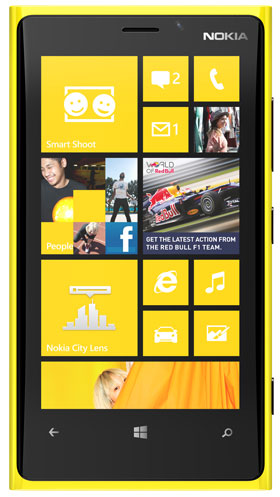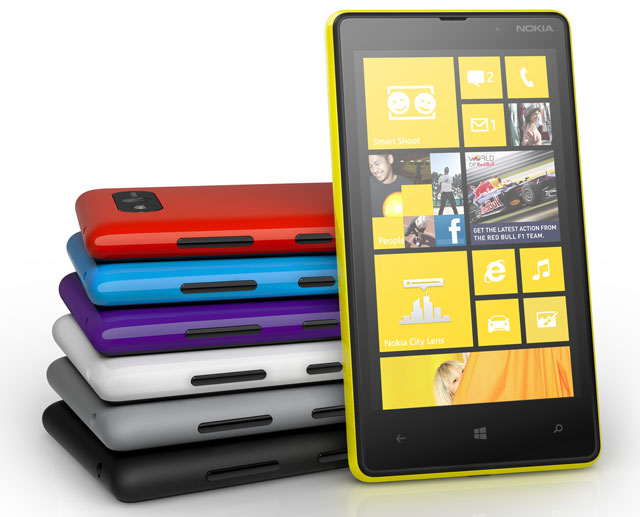
Finland’s Nokia is trying, once again, to capture the hearts of smartphone-loving consumers with the latest iterations of its Windows Phone-powered Lumia devices. The first Windows Phone 8 handsets from Nokia, the Lumia 920 and 820 include various hardware upgrades over their predecessors.
The company talked at length about its relationship with maker Microsoft and the importance of the partnership for both firms. With the next iPhone from Apple only a week away, though, the question on many consumers’ lips will be whether the two firms have done enough to see off their more profitable rival.
Microsoft CEO Steve Ballmer used the Nokia event to say this year will be crucial for the software maker. “Make no mistake about it, this is the year for Windows: Windows Phone, Windows tablets, Windows PCs.”
Ballmer said it was “unbelievable how far we’ve come in 18 months of working with Nokia”.
The Lumia 920 improves on the older 900 in a number of key areas — it offers a faster processor at 1,5GHz, doubles available RAM to 1GB and increases flash storage to 32GB. Also boosted is screen size, from 4,3 inches to 4,5 inches and the resolution from 800×480 pixels to 1 280×768 pixels. Video recording goes from 720p to 1 080p. The secondary camera is also improved.
Given the amount of time it spent talking about the 920’s camera, it’s clear the company sees this feature as the new phone’s key selling point. Gone is the 8-megapixel Carl Zeiss shooter found in the 900 in favour of an 8,7-megapixel “PureView” camera. Earlier this year, Nokia released the 41-megapixel PureView camera and although the 920 doesn’t offer this high resolution, Nokia says it includes many of its innovations.
The Lumia 920 includes optical stabilisation, which Nokia says means steadier images with better exposure, even in poor lighting conditions, because the camera’s shutter can be kept open for longer without introducing camera shake and the blur that accompanies it. It should also, according to Nokia, make for far steadier video footage than smartphone users are accustomed to.
In addition to the hardware upgrades, the Lumia 920 supports wireless charging. Place the device on compatible pads, docks or stands and it charges without the need to connect a cable. Users can, nevertheless, still charge the device’s bigger 2 000mAh battery via a micro USB port.
Lumia 820
The cheaper of the two new Lumias features a smaller, 4,3-inch display — but increased from the 3,7-inch display on the 800. Unlike the unibody design of the 920, the Lumia 820 is available with interchangeable covers, one of which also allows for wireless charging.
The 820 features the same 1,5GHz Snapdragon S4 processor of the 920, 1GB and 8GB of flash storage which can be supplemented with microSD cards up to 32GB in size.

Although the 820 keeps the 800 and 900’s primary 8-megapixel camera, it now includes a secondary VGA camera. The battery has also been bolstered to 1 650mAh from the 1 450mAh model found in the 800.
Steven Ambrose, MD of consulting firm Strategy Worx, says both Microsoft and Nokia are looking to Windows 8 and Windows Phone 8 as “the great unifiers”, but he’s not convinced this will materialise, at least not in the short term.
“It’s definitely time for a resurgence in the growth of Windows. But for the next year its not going to be a significant mobile competitor,” Ambrose says. “The biggest challenge Microsoft and Nokia faces is their lack of a ‘legacy of cool’ in the mobile space.”
Both companies have superb brand awareness and a healthy number of loyal users, but Ambrose says Windows Phone 8’s lack of history is going to take time to overcome. “The coherence across devices is not there yet and the app store is not developed enough.”
Ambrose also warns that both companies have been coy about how many of their applications designed for Windows Phone 7 will run on the newer operating system. “The install base of apps is much smaller than iOS or Android’s and the ecosystem is not yet seamless.”
Furthermore, he says that although Windows 8 is “leapfrogging” others with a coherent desktop, tablet and phone offering, this doesn’t mean applications will work as well across all devices. He says Apple has done a good job of carrying apps between desktop and mobile devices and Nokia will have to do likewise.
Though he expects both Microsoft and Nokia will spend a great deal on marketing to build awareness of Windows Phone 8 and devices running it, Ambrose says both the software and hard will have “a slow trajectory of success” with no big initial uptake.
Although the middle of the mobile handset market, particularly in SA, is still wrapped up by Nokia, the company wants to woo the “trendsetters and market leaders” with its new devices. “At the moment the Samsung Galaxy S3 is the ‘it’ phone,” says Ambrose.
Considering its head start, that’s really the bar Nokia has to clear.
Nokia has not revealed the likely price for the new handsets and is saying only that they will be available in “selected markets” in the fourth quarter. With the new iPhone expected to go on sale later this month, that could be a problem. — (c) 2012 NewsCentral Media




